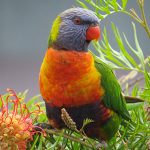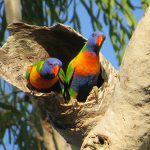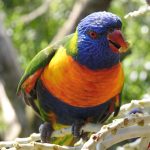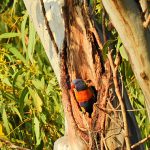RAINBOW LORIKEET
The Rainbow Lorikeet, with its riotous blend of colors, is a charismatic parrot species that calls the coastal stretches of eastern Australia home.
These medium-sized parrots, with a length spanning between 25-30 cm, boast a spectacular display of plumage. Their feathers are a tapestry of nature’s brightest hues: a vivid green canvas complemented by a deep blue crown, a fiery red beak, and a sun-kissed orange and yellow breast. When they take to the skies, their wings and tail feathers reveal a dazzling combination of green, blue, and ebony.
Remarkably adaptable, the Rainbow Lorikeet thrives across diverse environments, from the lush canopies of rainforests and coastal woodlands to the leafy retreats of urban parks and gardens.
These nectar-loving lorikeets have a sweet tooth for flowering plants, but their diet is also peppered with pollen, fruits, seeds, and the occasional insect. Their unique brush-tipped tongues are nature’s perfect tools for sipping nectar with remarkable efficiency.
Social interaction is the heart of Rainbow Lorikeet culture. They congregate in boisterous flocks that can number in the hundreds, painting the sky with their dynamic flight and playful antics. It’s not uncommon to see them dangling upside down, as if defying the world’s gravity, all while filling the air with their distinctive, high-pitched calls.
The breeding season, a time of courtship and companionship, spans from August to January. Rainbow Lorikeets are the epitome of avian romance, forming monogamous pairs that endure. In the seclusion of a tree hollow, the female tenderly lays one to three eggs, and both parents share the duties of incubation and nurturing their young.
While not facing a threat to their survival on a global scale, the Rainbow Lorikeet does encounter challenges. Habitat degradation, the sprawl of urban development, and the shadowy reaches of the illegal pet trade threaten their local numbers. In Australia, they find sanctuary under the protection of the law.
In urban settings, these lorikeets are a common, delightful sight, lured by the floral abundance of trees and gardens. They may grow familiar with human company, sometimes gracing bird feeders or accepting food from gentle hands. Yet, it’s imperative to remember that feeding wildlife, while done with the best intentions, is discouraged in order to maintain their natural behaviors and diet.
Through understanding and respecting these radiant birds, we can ensure that the Rainbow Lorikeet continues to soar freely and color our world with their presence.





